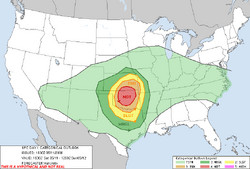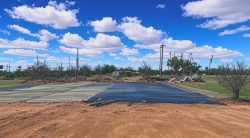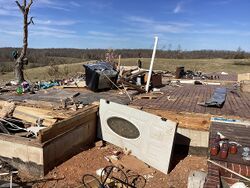Tornado outbreak of May 11-12, 2030
 The SPC's MODERATE Risk on May 11 | |
| Meteorological history | |
|---|---|
| Duration | 14 hours, 12 minutes |
| Tornado outbreak | |
| Tornadoes | 19 |
| Maximum rating | EF5 tornado |
|
| |
| Highest winds | Tornadic - 205 mph (330 km/h) (Moore, Oklahoma EF5 on May 11) |
| Overall effects | |
| Fatalities | 35+ |
| Injuries | 315+ |
| Damage | ~$2.1 billion (2025 USD) |
| Areas affected | Oklahoma, Kansas, Missouri |
| Power Outages | Unknown |
Confirmed tornadoes
| EFU | EF0 | EF1 | EF2 | EF3 | EF4 | EF5 | Total |
|---|---|---|---|---|---|---|---|
| 0 | 8 | 4 | 3 | 2 | 1 | 1 | 19 |
Moore, Oklahoma
 A well-built restaurant that suffered EF5 damage. | |
| Meteorological history | |
|---|---|
| Formed | May 11, 2030, 1:21 p.m. CDT (UTC-5:00) |
| Dissipated | May 11, 2030, 2:13 p.m. CDT (UTC-5:00) |
| Duration | 52 minutes |
| EF5 tornado | |
| on the Enhanced Fujita scale | |
| Highest winds | 205 mph (330 km/h) |
| Overall effects | |
| Casualties | 35+ fatalities, 315+ injuries |
The most violent tornado of the outbreak struck Moore, Oklahoma, on the afternoon of May 11, producing catastrophic EF5 damage across the city. It developed southwest of Newcastle at approximately 1:21 p.m. CDT and moved northeast, quickly intensifying into a large wedge tornado as it approached the Oklahoma City metro. The tornado reached a peak width of nearly 1 mile and remained on the ground for 15.1 miles before dissipating at 2:07 p.m. CDT near Lake Stanley Draper. Maximum estimated winds were recorded at 205 mph (330 km/h), with radar indicating a strong debris ball and high-end velocity couplet. The storm’s path closely mirrored those of the devastating EF5 tornadoes that impacted Moore in 1999 and 2013, passing through many of the same neighborhoods and subdivisions. Residential areas in southern and central Moore were particularly hard-hit, with entire blocks flattened and many homes swept completely from their foundations.
More than 2,000 homes and businesses were damaged or destroyed by the tornado. Numerous fatalities occurred in residential areas, particularly near Briarwood Elementary School and the Plaza Towers subdivision. While both schools sustained damage, classes were not in session due to the tornado striking on a Saturday, likely preventing further loss of life. Briarwood Elementary suffered partial roof failure and damage to multiple classrooms, while Plaza Towers Elementary — rebuilt after its 2013 destruction — endured significant roof and facade damage, though its reinforced structure remained standing. The tornado’s EF5 rating was assigned based on the total destruction of a well-engineered, anchor-bolted restaurant in southern Moore, the only damage indicator to exceed EF4 thresholds. Debris from the restaurant was scattered hundreds of yards, and anchoring systems were found ripped or sheared. Vehicles were thrown long distances, and several were wrapped around trees or shredded beyond recognition.
In total, the Moore tornado resulted in at least 35 fatalities and over 315 injuries, making it the deadliest single tornado of the 2030 outbreak and one of the deadliest in Oklahoma history since 2013. Emergency response teams described the scene in Moore as chaotic, with blocked roads, power outages, and overwhelmed communications infrastructure. The tornado knocked out power to tens of thousands of residents, ruptured gas lines, and temporarily disabled cell towers and 911 systems. Search and rescue efforts were hampered by debris piles that exceeded ten feet in some areas. Recovery of victims took days, with final identification of all deceased individuals not completed until nearly three weeks later. The National Weather Service and emergency managers praised the effectiveness of early warnings and weather radios, though the tornado’s speed and strength left little time for many to seek shelter. Estimated damage from the Moore tornado alone exceeded $2.1 billion, placing it among the costliest tornadoes in U.S. history. The event once again reignited discussion about tornado resilience, especially in Moore, which has now been struck by three EF5 tornadoes in just over three decades.
El Reno, Oklahoma
 A home suffering low-end EF4 damage near downtown El Reno. | |
| Meteorological history | |
|---|---|
| Formed | May 11, 2030, 2:58 p.m. CDT (UTC-5:00) |
| Dissipated | May 11, 2030, 3:41 p.m. CDT (UTC-5:00) |
| Duration | 43 minutes |
| EF4 tornado | |
| on the Enhanced Fujita scale | |
| Highest winds | 170 mph (270 km/h) |
| Overall effects | |
| Casualties | 8 fatalities, 38 injuries |
Impact
The tornado outbreak caused widespread destruction across Oklahoma, Kansas, and Missouri, with several intense and long-track tornadoes contributing to significant loss of life and property. Of the 19 tornadoes confirmed during the event, five were particularly notable for their strength, duration, and impacts.
The most catastrophic tornado of the outbreak occurred in Moore, Oklahoma, where an EF5 tornado struck densely populated neighborhoods. The tornado carved a 15.1-mile path through Cleveland and Oklahoma counties, killing at least 35 people and injuring more than 315 others. With peak winds estimated at 205 mph (330 km/h), the tornado completely destroyed thousands of structures, including homes, schools, and businesses, and caused an estimated $2.1 billion in damage. This was the third EF5 tornado to strike Moore in just over 30 years, following similar disasters in 1999 and 2013.
Another violent tornado touched down in El Reno, Oklahoma, later rated EF4. The tornado tore through industrial areas and residential neighborhoods on the southern edge of the city, leveling several metal warehouses and severely damaging homes. Multiple injuries were reported, and damage totals exceeded several hundred million dollars. Wind speeds were estimated to have peaked between 170–180 mph. Though less deadly than the Moore tornado, the El Reno EF4 was the second most powerful of the outbreak and caused considerable infrastructure disruption.
In Tulsa, Oklahoma, a large EF3 tornado impacted the city’s western suburbs during the early evening hours. The tornado damaged dozens of homes and businesses and downed hundreds of trees and power lines. Emergency officials noted that early warning systems helped reduce injuries, though several people were hospitalized, and numerous homes were declared uninhabitable. The tornado’s track spanned several miles across the metro, damaging multiple shopping centers and apartment complexes.
To the north, an EF3 tornado affected the Ponca City area in north-central Oklahoma. The tornado remained on the ground for over 20 minutes and caused heavy damage to agricultural structures and rural homes. Several large barns were completely destroyed, and debris was thrown across highways. Despite the intensity of the storm, no fatalities were reported, though a handful of residents were treated for storm-related injuries.
Farther east, one EF2 tornado tracked across southeastern Kansas before crossing into southwestern Missouri, narrowly missing the city of Joplin. The tornado damaged homes, power lines, and outbuildings in Jasper County, Missouri, particularly in rural communities west of Joplin. Several injuries occurred as mobile homes were overturned and trees fell onto occupied structures. Local emergency services referenced the 2011 Joplin tornado in press briefings, expressing relief that the storm had remained west of the urban center.
Overall, the outbreak killed at least 35 people and injured over 315. The vast majority of casualties occurred in Moore, though tornado-related injuries were reported in at least four counties across three states. Emergency declarations were issued at both state and federal levels, and thousands of first responders were deployed throughout the region to assist with rescue, damage assessment, and recovery.
